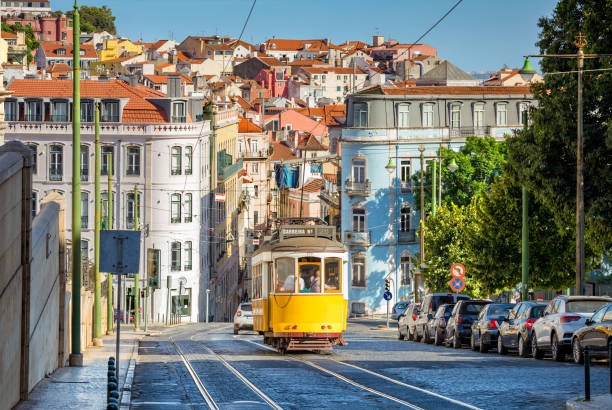Lisbon has this magnetic pull. The terracotta rooftops, the yellow trams rattling up impossible hills, those custard tarts that make you question every dessert you’ve ever eaten before. It’s easy to fall head over heels for this city.
But here’s what nobody tells you in those glossy travel magazines. Lisbon has its quirks, its pitfalls, its little traps that can turn your dream vacation into a frustrating afternoon of wrong turns and wasted euros. I’ve watched enough tourists make the same mistakes to know exactly where things go sideways.
Your trip doesn’t have to be one of them. Let me walk you through what to skip, what to watch for, and how to experience Lisbon like someone who actually knows their way around.

Things to Avoid in Lisbon
You’re about to discover the mistakes that trip up even seasoned travelers. These aren’t just minor inconveniences—they’re the difference between a good trip and an unforgettable one.
1. Taking Taxis From the Airport Without Checking the Meter
That friendly driver offering you a flat rate of €40 to get downtown? He’s counting on you saying yes before you do the math. The actual metered fare from Lisbon Airport to the city center runs about €12-€15 during the day, maybe €18 at night with the extra charges.
I’ve seen this happen dozens of times. Travelers land, they’re tired, they just want to get to their hotel. A driver approaches with a smile and a “special price,” and suddenly you’re paying triple what you should. The worst part? It feels legitimate because you agreed up front.
Here’s what you do instead. Always insist on the meter. It’s called a “taxímetro,” and by law, every licensed taxi must use it. If a driver refuses or claims it’s broken, walk away. Better yet, use ride-sharing apps like Uber or Bolt—they’re cheaper, transparent, and you’ll know the price before you even get in the car. The metro is another solid option at just €1.50 plus a €0.50 reusable card fee, though you’ll need to manage your luggage on the escalators.
2. Wearing Flip-Flops or Smooth-Soled Shoes for City Exploration
Lisbon sits on seven hills. Those picturesque cobblestone streets you see on Instagram? They’re made of calçada portuguesa—small limestone and basalt cubes arranged in decorative patterns. Beautiful to photograph. Treacherous to walk on, especially when wet.
Your cute sandals or those sleek leather loafers are going to betray you. The cobblestones get slippery after rain, and even on dry days, the uneven surface will have your feet screaming by noon. I once watched a woman in flip-flops try to climb the steps up to São Jorge Castle. She made it halfway before admitting defeat and buying overpriced sneakers from a tourist shop.
Pack shoes with grip. Real grip. Those thick rubber soles that you might think look clunky? They’re your best friends here. Your ankles will thank you when you’re climbing Alfama’s steep alleys or descending from Bairro Alto after sunset. This isn’t optional advice—it’s the difference between enjoying your day and limping back to your hotel.
3. Eating Dinner Before 8 PM
You’ll walk past restaurants at 6:30 PM and find them empty. Maybe one or two tables occupied by confused tourists checking their phones. That’s not because the food is bad—it’s because you’re eating on the wrong schedule.
Portuguese people eat late. Lunch happens around 1 or 2 PM, and dinner rarely starts before 8:30 or 9 PM. Some of the best local spots don’t even open their kitchens until 7:30. If you show up at 6, you’ll either find doors locked or you’ll be sitting alone in a restaurant that hasn’t hit its stride yet.
This matters more than you think. The atmosphere at 9 PM—when locals fill the tables, when the kitchen is fully operational, when the energy picks up—is completely different from the quiet, awkward vibe two hours earlier. You’ll get fresher food, better service, and an authentic sense of how people actually live here. Adjust your schedule. Have a late afternoon snack at a pastelaria (those custard tarts work perfectly), then head to dinner when the city comes alive.
4. Buying Pastéis de Nata Anywhere Other Than Belém
Every bakery, café, and corner shop in Lisbon sells these iconic custard tarts. Most of them are fine. Some are even good. But if you leave Lisbon without tasting the original from Pastéis de Belém, you’ve missed the point entirely.
The recipe at this place dates back to 1837, created by monks from the nearby Jerónimos Monastery. It’s still a guarded secret, and yes, you can taste the difference. The pastry shatters differently. The custard has this depth of flavor that the mass-produced versions just can’t match. Even the slight char on top tastes intentional rather than accidental.
The line looks intimidating, but move past that concern. It moves faster than you’d expect, and the shop is massive inside—multiple rooms with hundreds of seats. Go in the morning around 9 or 10 AM if you want to avoid the worst of the crowds. Order at least two tarts per person (trust me on this), sprinkle them with cinnamon and powdered sugar, and eat them warm. The price difference between here and tourist trap cafés is negligible anyway, so you might as well get the real thing. Skip the imitators. This is one experience where the hype is actually justified.
5. Relying on Your Phone’s GPS in Old Town Neighborhoods
Alfama and Mouraria are medieval mazes. Streets that twist back on themselves, staircases that appear out of nowhere, alleys barely wide enough for one person. Your GPS will confidently tell you to turn right, and you’ll find yourself facing a wall or someone’s laundry hanging across what might technically be classified as a “street.”
Technology hits its limits here. The old neighborhoods were built long before anyone thought about grid systems or logical navigation. Satellite signals bounce off buildings. Maps show paths that don’t exist or miss stairways that do. I’ve watched people walk in circles for 20 minutes, staring at their phones with increasing frustration, standing three minutes from their destination.
Get comfortable with getting a little lost. It’s actually part of the charm, though I know that sounds like something a travel blogger would say to justify their own poor planning. But seriously—these neighborhoods reward wandering. Ask locals for directions. Look for landmarks. Use your phone as a rough guide, but don’t follow it blindly. Some of the best restaurants, viewpoints, and hidden courtyards reveal themselves only to people who’ve taken a wrong turn and stumbled into something unexpected.
6. Skipping the €1 Couvert Charges on Your Restaurant Bill
You sit down at a restaurant. The server brings bread, butter, olives, and maybe some cheese or pâté. You didn’t order these, but there they are. You nibble on the bread because it’s warm and you’re hungry. Then the bill comes with a “couvert” charge of €1-€3 per person, and suddenly you’re annoyed because you didn’t ask for any of this.
This is standard practice throughout Portugal, not a scam. Couvert charges are legal, expected, and stated on menus (usually in small print at the bottom). Those appetizers aren’t free samples—they’re optional starters. If you don’t want them, you can politely refuse when the server brings them, and you won’t be charged.
But here’s my actual advice: just pay the euro or two. The bread is usually excellent, baked fresh that day. The olives are marinated in-house. For the price of a mediocre coffee back home, you’re getting something that genuinely enhances your meal. Fighting over €1.50 while sitting in a beautiful Portuguese restaurant overlooking the Tagus River seems like missing the forest for the trees. Save your energy for things that actually matter. This is one of those cultural differences that’s easier to embrace than resist.
7. Visiting Only Baixa and Ignoring the Other Neighborhoods
Baixa is where most tourists spend 90% of their time. The grand plazas, the Elevador de Santa Justa, and the wide pedestrian streets filled with shops. It’s impressive. It’s photogenic. It’s also a bit sanitized and tourist-focused, like the downtown area of any major city.
The real Lisbon happens in neighborhoods that don’t make it onto most itineraries. Campo de Ourique has tree-lined streets, a fantastic food market, and restaurants where you’ll hear Portuguese at every table. Príncipe Real offers upscale shopping, beautiful gardens, and some of the city’s best cocktail bars. Marvila is the edgy, up-and-coming area where old warehouses have transformed into art galleries and craft breweries.
Each neighborhood has a different personality, different energy, and different food. Staying in Baixa means you’re experiencing tourist Lisbon, not actual Lisbon. Take the tram to different areas. Spend an afternoon wandering through residential streets where people walk their dogs and kids play football in small squares. Eat at neighborhood tascas where the menu is handwritten and the owner remembers regulars by name. That’s where you’ll find the stories you’ll actually tell when you get home.
8. Attempting to Drive in the City Center
Renting a car for day trips outside Lisbon? Great idea. Driving that car through Lisbon’s streets? Absolutely terrible idea that will age you several years in a single afternoon.
The streets are narrow—like “fold in your mirrors and hold your breath” narrow. Parking is nearly impossible to find and expensive when you do. The tram tracks create one-way corridors that don’t match what your GPS thinks should happen. Hills mean you’ll be doing manual clutch control at 45-degree angles while someone honks behind you. And those beautiful cobblestones? They’re slippery when you need to brake.
Lisbon has excellent public transportation. The metro, trams, buses, and even funiculars can get you anywhere you need to go for a fraction of the stress and cost. A 24-hour pass costs €6.40 and covers unlimited rides on all public transport. Compare that to parking fees of €2-€3 per hour, plus gas, plus the mental exhaustion of navigating unfamiliar streets. If you need a car for exploring beyond the city—Sintra, Cascais, the Alentejo region—pick it up on your way out of town. Leave Lisbon itself to the public transport system that was designed for exactly this purpose.
9. Exchanging Money at Airport Currency Exchange Booths
Those exchange counters right when you walk out of arrivals? They’re offering you roughly 10-15% less than the actual exchange rate. They advertise “no commission,” which is technically true—they just build their profit into a horrible exchange rate instead.
A €100 exchange at the airport might net you €85-€90 worth of actual value. Do that a few times during your trip, and you’ve essentially donated a nice dinner’s worth of money to a currency exchange company. It’s one of the oldest tourist traps in existence, and it works because people are tired from their flight and want cash immediately.
Use ATMs from actual banks once you get to the city. They give you the real interbank exchange rate (or very close to it), minus a small fixed fee from your home bank. Even better, many credit cards now offer no foreign transaction fees—use those for most purchases and only withdraw small amounts of cash for places that don’t take cards. Places like Multibanco ATMs are everywhere in Lisbon, safe and reliable. You’ll save enough money to fund an extra day trip or several more of those custard tarts you’ve become obsessed with.
10. Booking Accommodation Far From a Metro Station
That charming Airbnb on the hill looks perfect. Amazing views, reasonable price, lots of character. Then you realize it’s a 15-minute uphill walk from the nearest metro station, and suddenly every trip into town becomes a sweaty ordeal.
Lisbon’s hills are no joke. What looks like a short distance on a map can mean climbing 100 steps or walking up a 20% grade. After a full day of sightseeing, that walk back to your accommodation feels exponentially longer. You’ll find yourself taking expensive Ubers for trips you could easily metro, just because you can’t face another climb.
Location matters enormously here. Look for places within a five-minute walk of metro stations on the Green or Blue lines. These give you quick access to most major attractions. Neighborhoods like Santos, Cais do Sodré, or even parts of Graça near metro stops offer the best of both situations—local atmosphere without the transportation headaches. Yes, you might pay €10-€20 more per night. But you’ll save that in Uber rides on day two, plus you’ll actually enjoy getting around instead of dreading it.
Pay attention to elevation on the listing maps. Those 3D views exist for a reason. Read reviews specifically mentioning accessibility. A place that’s “authentic” and “up in the hills” sounds romantic until you’re hauling groceries up those authentic hills in the authentic heat. Pick accommodation strategically, and everything else gets easier.
Wrapping Up
Lisbon is going to surprise you. It’ll exceed your expectations in ways you didn’t anticipate and trip you up in others you never considered. That’s part of what makes it such a compelling place—it refuses to be just another European capital that you tick off a list.
These ten mistakes aren’t the end of your trip if they happen. But avoiding them means you’ll spend less time frustrated and more time soaking in everything this city offers. You’ll eat better food, meet more locals, see more authentic neighborhoods, and come home with stories that don’t start with “we wasted half a day because…”
Pack good shoes, adjust your dinner schedule, explore beyond the tourist center, and keep your expectations flexible. Lisbon rewards people who pay attention, who adapt, who let themselves get a little lost in the old town and trust that the way forward will reveal itself. Your trip starts the moment you step off that plane. Make these choices count.


